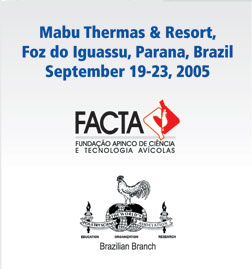Contributed Papers: Oral Presentations
Chemotherapy |
THE IMPACT OF
COCCIDIAL DRUG-RESISTANCE ON THE COMMERCIAL PERFORMANCE
OF BROILERS
R. B. Williams
Coxitec Consulting, Hertfordshire, UK
E-mail address: ray.coxitec@tesco.net
Coccidial
drug-resistance is often said to be a serious problem
to the chicken industry, but broiler performances
indicate that resistant parasites are often tolerated
by the host. How can this be? The present retrospective
synthesis of laboratory and field studies of coccidial
drug-resistance, population dynamics and epidemiology
is instructive. Some synthetic or ionophorous anticoccidial
drugs may control clinical coccidioses while allowing
some oocyst “leakage”. This phenomenon,
when there has been no prior exposure of coccidia
to a particular drug, reflects a fundamental drug-parasite
interaction which Ryley (1980) termed “drug
insensitivity”. True drug-resistance involves
selection.
Williams (1972) demonstrated pre-existing mutants
in coccidial populations, selectable during a single
life cycle in the presence of the synthetic quinolone,
decoquinate. This was termed “inherent resistance”,
distinguished from “acquired resistance”,
a gradual physiological adaptation over several generations
facilitating preferential survival of the least sensitive
individuals, not necessarily mutants. Ionophores,
which affect ion transport across cell membranes,
are fundamentally different from chemicals active
against cofactor synthesis or electron transport.
Selection of physiological variants during a single
passage in monensin-medicated birds results in far
less reduction in sensitivity than selection of decoquinate-resistant
mutants (Williams, 1998). Thus, ionophore-resistance
is probably “acquired”, and quinolone-resistance
is “inherent”. Hence, in all cases of
drug insensitivity, inherent resistance or acquired
resistance, oocysts are produced in the presence of
drug under commercial conditions. Their effect is
crucial.
Oocyst production by chickens first increases, until
marked reductions occur towards the end of each crop,
due to development of flock immunity, stimulated by
early exposure to oocysts that have avoided drug action.
Adverse litter conditions further reduce numbers of
viable oocysts, but small numbers remain at the end.
The pattern is similar with untreated birds and those
receiving live anticoccidial vaccines. The often innocuous
immunization occurs as a result of the initiation
of strongly immunogenic trickle infections by between-crop
carry-over of residual oocysts. The phenomenon is
most marked if litter is replaced between crops.
Other factors moderating the impact of resistant populations
include a physiological compensation that allows infected
chicks to attain increased growth rates during recovery
from coccidiosis, and the effect of E. acervulina
in evidently suppressing more pathogenic Eimeria species
under certain conditions (Williams, 1973). Adverse
effects of drug-resistant parasites might, therefore,
be ameliorated by such natural events, supported by
careful husbandry.
